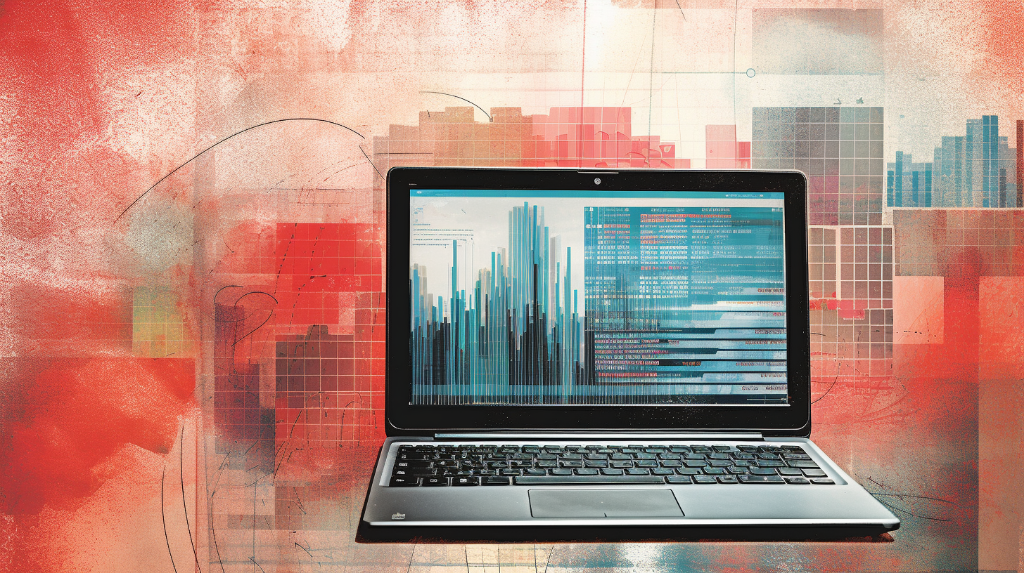Data Analytics, in its simplest form, is the science of analyzing raw data to draw conclusions about that information. It’s a process that involves applying specific algorithmic or mechanical procedures to derive insights. Data Analytics is used across various industries, allowing companies and organizations to make better decisions, as well as verify or disprove existing theories or models.
As a beginner, understanding data analytics can seem daunting. But with the right approach, it becomes a fascinating field that opens up a world of possibilities. This article will introduce you to the basics of data analytics, its importance in today’s data-driven world, and the core concepts that form its foundation.

The Importance of Data Analytics in Today’s World
We live in a world saturated with data. From the products we buy to the services we use, every action generates data. But what does this mean for us and why is data analytics important?
The sheer volume of data is growing exponentially, and it’s not slowing down. This data, if analyzed correctly, can provide invaluable insights that can influence strategic decisions and shape outcomes. Without data analytics, this vast amount of data is just noise. The ability to sort through this data, find patterns, and make sense of it all is what makes data analytics crucial in today’s world.
Whether it’s predicting customer behavior, improving operational efficiency, or driving innovation, data analytics plays a pivotal role in various aspects of business. It’s no wonder then that organizations across industries are harnessing the power of data analytics to stay competitive and relevant in this data-driven era.
The Core Concepts of Data Analytics
At the heart of data analytics lie a few core concepts. Understanding these will give you a solid foundation to build upon as you venture deeper into the field of data analytics.
The first of these is data mining. This is the process of discovering patterns in large data sets. It involves methods at the intersection of machine learning, statistics, and database systems.
Statistical analysis is another key concept. It involves collecting and scrutinizing every data sample in a set of items from which samples can be drawn. A sample, in statistics, is a representative selection drawn from a total population.
The third concept is predictive modeling, which uses statistics to predict outcomes. Most often the event one wants to predict is in the future, but predictive modelling can be applied to any type of unknown event, regardless of when it occurred.
Lastly, machine learning, a type of artificial intelligence (AI), provides systems the ability to automatically learn and improve from experience without being explicitly programmed. It’s a method of data analysis that automates analytical model building.
Understanding the Data Analytics Process
Data analytics is not just about numbers and graphs; it’s a systematic process that involves several steps. Understanding these steps can give beginners a comprehensive understanding of how data analytics works and its importance in decision making. Let’s break it down.
Data Collection and Preparation
The first step in the data analytics process is data collection. Data can come from a variety of sources, such as databases, online resources, customer feedback, and more. The type of data collected will depend on the goal of the analysis. For instance, a company looking to improve customer satisfaction might gather data from customer surveys and feedback forms.
After the data is collected, it undergoes a process known as data cleaning or data preparation. This process involves checking the data for errors, inconsistencies, and redundancies, and correcting them to ensure the accuracy of the analysis. It’s a crucial step as the quality of data directly impacts the insights drawn from it.
Data Analysis and Interpretation
Once the data is clean and ready, it’s time for the actual analysis. This involves applying statistical techniques and algorithms to the data to uncover patterns, correlations, and trends. The type of analysis used can vary based on the nature of the data and the specific objectives of the analysis.
The data analysis phase is followed by data interpretation. This step is about making sense of the results of the analysis. The data might reveal interesting patterns, but what do those patterns mean? How do they relate to the problem or question at hand? Data interpretation involves answering these questions and more. It’s where the raw results of the analysis are transformed into actionable insights.
Different Types of Data Analytics
Data analytics is a broad field with several subfields, each with its own focus and methods. Generally, data analytics can be divided into four main types: descriptive, diagnostic, predictive, and prescriptive analytics. Understanding these categories can help you understand the depth and breadth of this field.
Descriptive Analytics is the most basic type of data analytics. It involves analyzing historical data to understand what has happened in the past. For instance, a business might use descriptive analytics to understand sales trends over the past year.
Diagnostic Analytics goes a step further and tries to understand why something happened. It involves drilling down into data to understand the root cause of a particular outcome.
Predictive Analytics uses statistical models and forecasting techniques to understand the future. It’s about predicting what is likely to happen based on the data from the past. For example, a retailer might use predictive analytics to forecast future sales trends.
Finally, Prescriptive Analytics recommends actions based on the results of descriptive, diagnostic, and predictive analytics. It’s about answering the question, “What should we do?” For example, based on the analysis of past sales data and future predictions, what should the retailer do to increase sales?
Tools and Techniques Used in Data Analytics
Data analytics doesn’t only involve an understanding of statistics or the ability to interpret charts and graphs. It also requires the use of various specialized tools and techniques. These tools can range from software for data visualization to programming languages specifically designed for statistical analysis.
Let’s look at some of the most commonly used tools in the field of data analytics:
- Python: This is a high-level, interpreted programming language with a design philosophy that emphasizes code readability. Python is widely used for data manipulation and analysis.
- R: R is another programming language and free software environment which is widely used among statisticians and data miners for developing statistical software and data analysis.
- SQL: Structured Query Language (SQL) is used to communicate and manipulate databases. It is particularly useful in handling structured data, i.e., data incorporating relations among entities and variables.
Now, let’s talk about some of the techniques used in data analytics:
- Data Mining: This technique involves exploring and analyzing large amounts of data to discover meaningful patterns and rules.
- Data Cleaning: This is a crucial part of the data analytics process. It involves checking for errors and inconsistencies in the data and correcting or deleting them.
- Data Visualization: This technique involves presenting data in a pictorial or graphical format, making complex data more understandable and usable.

Careers in Data Analytics
The field of data analytics has seen significant growth in recent years. As businesses continue to realize the importance of data-driven decision making, the demand for data analytics professionals has skyrocketed. These roles require a unique blend of skills, including technical know-how, an understanding of business operations, and the ability to communicate complex concepts clearly.
There are a variety of roles available in the field of data analytics. Each role has its unique set of responsibilities, required skills, and potential salary ranges. Let’s explore some of these roles:
| Job Role | Required Skills | Salary Range |
|---|---|---|
| Data Analyst | Statistical skills, data cleaning, data visualization, Python/R | $60,000 – $90,000 |
| Data Scientist | Machine learning, predictive modeling, Python/R, SQL | $90,000 – $140,000 |
| Data Engineer | Data warehousing, ETL, Hadoop, SQL | $80,000 – $120,000 |
| Business Analyst | Business intelligence, SQL, data visualization | $70,000 – $100,000 |
| Machine Learning Engineer | Python/R, machine learning algorithms, data modeling | $100,000 – $150,000 |
Real-world Applications of Data Analytics
Data analytics is not just about number crunching and deciphering complex data sets. It has practical, real-world applications that have transformed industries and the way we live. Let’s take a look at some of these applications.
Healthcare: In the healthcare industry, data analytics is used to predict disease outbreaks, improve patient care, and make better medical decisions. It helps in identifying patterns and trends in patient data, leading to more effective treatments and improved patient outcomes.
Finance: Financial institutions use data analytics for risk assessment, fraud detection, customer segmentation, and portfolio management. By analyzing historical data, they can predict future trends and make strategic decisions.
Retail: Retailers use data analytics for inventory management, customer segmentation, pricing strategies, and sales forecasting. It helps them understand customer behavior and preferences, leading to improved customer service and increased sales.
Getting Started with Data Analytics
If you’re keen to dive into the field of data analytics, there are loads of resources available to help you get started. Here are some recommended courses, books, and online resources:
- Course: “Data Science and Machine Learning Bootcamp with R” on Udemy
- Book: “Data Science for Business” by Foster Provost and Tom Fawcett
- Online Resource: Kaggle – a platform for predictive modelling and analytics competitions.
- Course: “Applied Data Science with Python” on Coursera
- Book: “Python for Data Analysis” by Wes McKinney
- Online Resource: DataCamp – an online learning platform for data science and analytics.
The Future of Data Analytics
Data analytics is a rapidly evolving field, with new technologies and techniques emerging all the time. As we head into the future, some trends are likely to shape the landscape of data analytics.
One of the key trends is the rise of artificial intelligence and machine learning. These technologies are becoming increasingly integral to data analysis, enabling businesses to make more accurate predictions and decisions.
Another trend is the growth of big data. As the volume of data continues to increase, so does the demand for professionals who can analyze and interpret this data.
Finally, we can’t ignore the impact of data privacy and security. As more data is collected and analyzed, the need for robust data protection measures is paramount. This is likely to be a key area of focus in the future of data analytics.
